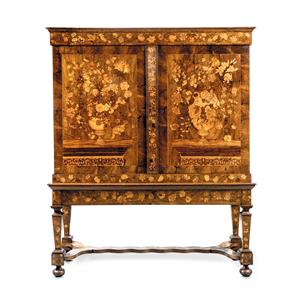DÉTAILS DE L'IMAGE

Zebregs&Röell Fine Art and Antiques
Jan van Mekeren (Tiel 1658-1733 Amsterdam)
't Blommenkabinet’
Dutch floral marquetry cabinet-on-stand
Amsterdam, late 17th century
H 206 x W 171 x D 61 cm
The present and V&A cabinet were both possibly ordered by Jens Wijbergen, a Dutch merchant living in Copenhagen. According to the van Mekeren archives, an order was placed by Wijbergen in 1700, probably for two cabinets, because the price was comparable to other orders for a pair of van Mekeren cabinets. The previous owner of the present cabinet, living in Austria, is a descendant of a patrician family from Riga. Some members of the Danish Wijbergen family are known to have moved to Riga in the early eighteenth century.
The cabinet and all its oak bases have been retained in their original state. The whole cabinet is covered with a floral marquetry veneer of various kinds of wood, including walnut, holly, laburnum, boxwood, satiné rubané, amaranth, tulipwood, barberry, elm, sycamore, olive wood, padouk and kingwood. A modest rectangular cornice over a frieze inlaid with marquetry of various flowers over two doors with marquetry depicting urns on a plinth issuing bouquets of tulips, bluebells, cornflowers, marigolds, irises, peonies, daffodils, crown imperials, roses, lilies, anemones, chrysanthemums and carnations; several different species of butterflies and moths, including Arctia caja, swallowtails, garden white, meadow brown, and a brimstone butterfly, at least three different bird species, including turtle dove, thrush, and warbler, and a garden snail, Cepaea hortencis.
Jan van Mekeren, born in Tiel 1658, moved to Amsterdam in 1687, where he was recorded as ‘kabinetmaker’ or ‘kistenmaker’. Before moving to Amsterdam, he had been in London in 1682, where he had asked to be admitted to the Dutch Reformed Church. He apparently wanted to stay for some time in London, presumably to learn the art of furniture marquetry under Gerrit Jensen. In 1687, he was back and mentioned as a guildsman, a member of the St. Josef guild in Amsterdam. He was successful as a cabinetmaker because, in 1693, he bought a house in the expensive Kalverstraat and extended his business into the wood trade as well. Since the headquarters of the VOC was in Amsterdam, the city was the foremost European market for exotic woods in the seventeenth century.
Despite a 1624 regulation stipulating that members of the Amsterdam cabinetmaker’s guild offer their wares for sale in the guild’s shop, furniture makers in seventeenth and eighteenth century Holland hardly ever marked their work. However, thanks to the inventory after Jan’s death, there is a good list of his workpieces with thorough descriptions, prices, and the names of his clientele. The estate included many finished and unfinished pieces of furniture, an extensive collection of cabinet woods, and, most interesting, a long list of claims with names of the debtors and the amounts due. Most debtors were well-known Amsterdam patricians; only a few were from outside Amsterdam, including Jens Wijbergen from Copenhagen, who still owed Jan van Mekeren fl. 33,13.
Because of a very close resemblance, this cabinet possibly is the pendant of the Van Mekeren cabinet now in the Victoria & Albert Museum (W.5:1 to 14-1986). There are minor differences in the flower decorations on the doors and sides of the cabinet. Still, a pair of Van Mekeren cabinets in Amerongen Castle, ordered as a pair, look less like each other than the present cabinet and its possible pendant in the V&A.
Only six other floral Van Mekeren cabinets are known: one in the Rijksmuseum Amsterdam (inv. R.B.K. 1964-12), one in the Metropolitan Museum New York (1995, 371a, b), one in the Victoria and Albert Museum, one in Charlecote Park, Warwickshire, and a pair in Amerongen Castle, the Netherlands.



 TÉLÉCHARGER L'IMAGE
TÉLÉCHARGER L'IMAGE